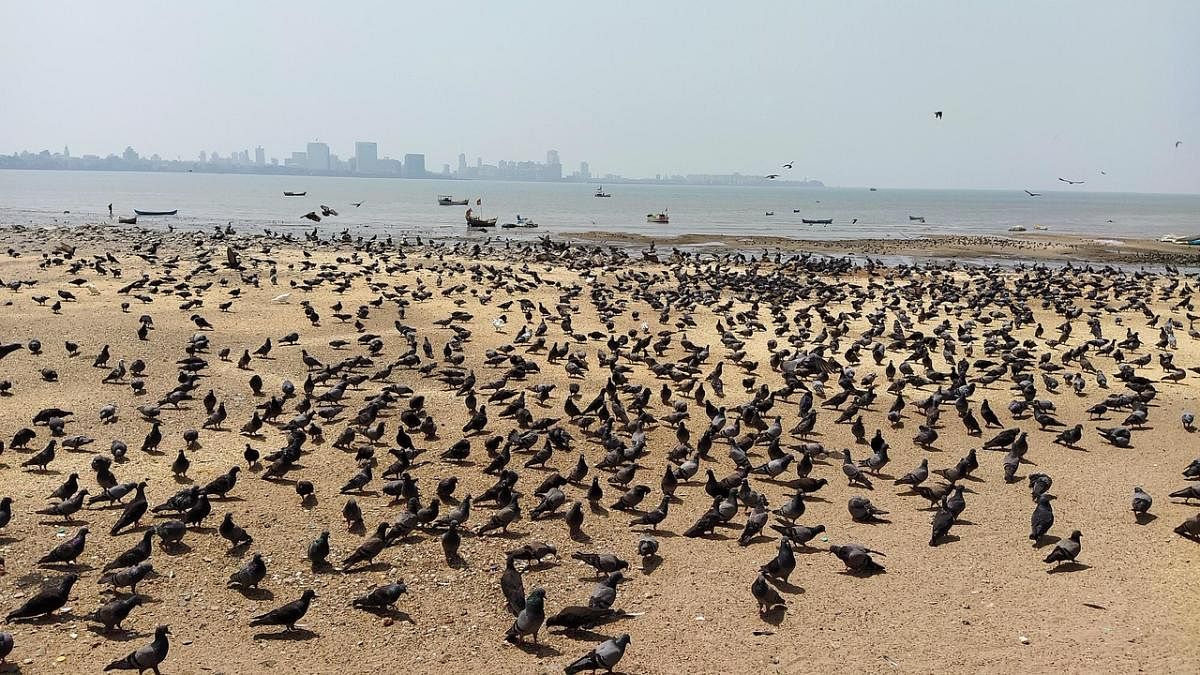
As it peeped from between two parked cars, a couple of policemen, masked and armed, holding fort at South Mumbai’s Babulnath Zone turned abruptly in response. Anticipating a motorcyclist breaking the lockdown and zipping through the parked vehicles, a police constable bolted towards the spot, a hand holding onto his mask and another with a raised baton only to find a peacock emerging and fanning out its full plumage.
Astounded by the appearance of the bird in an otherwise-crowded residential zone, the constable stood transfixed as it strutted about, oblivious of the penal threat, attempting to catch the attention of a peahen that stood tall atop the bonnet of a parked car.
As the peahen bolted across the road to enter a temple premises, the peacock followed in hot pursuit even as the constable grappled with his mobile to grab a photograph for the record. After all, it is not common to find peacocks in pursuit of peahens on a South Mumbai road. This, among a string of other instances of nature healing itself as humans of the world’s largest democracy remained, locked down in the times of coronavirus.
A little distance away, at Girgaum Chowpatty, a swarm of pigeons inundated the zone covering long stretches of sand. “They’ve taken over the place where a demolished kabootar khana (feeding place for pigeons) stood, broken down by the authorities for want of legality. You can break down a structure but how can you take action against thousands of pigeons who have decided to break the law,” says Pardhi Savitri, a roadside flower seller, now rendered jobless owing to the lockdown, yet, hooded to protect herself from Covid-19.
Her daughter Laxmi, a dishevelled Pardhi girl all of six, stood with grains in her small palm and a pigeon pecked away without fear, the distinction between the tribal and nature stood blurred.
about at South Mumbai’s Babulnath area
Attempts by the civic authorities to rid Mumbai of the birds and urban tribals like the Pardhis have been legendary. They fail miserably as the two continue to exist in sweet, free harmony even as the rest of the city stands locked down.
Cut to Ahmedabad in Gujarat where monkeys have taken over the main commercial zones around Ashram Road and C G Road in Ahmedabad West. As they playfully prance in groups, chattering away loudly in wild abandon on the usually congested roads of commercial Ahmedabad, the city’s business community stays back home, abiding by the national lockdown to soften the blow of an all-powerful virus.
“The monkeys, who had been relegated to the green campuses of the city, like C N Vidyalaya, the Centre for Environmental Planning and Technology (CEPT) and the IIM campus, have now spilled over to the rest of the city where they were usually beaten up and made to flee. It’s almost like poetic justice,” says an exhilarated city artist Hasmukh Makwana.
“It would be very painful to watch car owners speeding down the roads of Ahmedabad West in full disregard for the stray monkeys who would often get knocked over and left with serious injuries to die on the roads,” says Hasmukh. “Today, with all vehicles off the roads, the monkeys are back to their antics and, this time, without the fear of being run over too,” he adds.
As Goa’s Atal Setu — India’s third longest cable-stayed bridge — earmarked only for four-wheelers today stands empty with the lockdown, it has been taken over by storks and all sorts of multi-hued water birds such as kingfishers at the edge of the bridge and the Brahminy Kites, glorious in their white-breasted demeanour, as they sit perched atop strategic spots waiting to spot their potential meals on the Mandovi River far below.
And, in Kolkata, air pollution has been reduced by almost 75 percent during the lockdown, according to the West Bengal Pollution Control Board.
“The lack of vehicles and the
absence of noise has enabled birds, we’ve seen only in wildlife documentaries, emerge out in the open. For the first time in my life, I saw a pale-billed flowerpecker, I thought
was a sparrow, till an informed bird-lover friend told me about it,” offered a South Kolkata resident and insurance agent Neelkanth Dey.
In India’s capital, New Delhi, the average concentration of PM 2.5 plunged by 71 percent within just a week of the lockdown. It fell from 91 microgram per cubic meter on March 20, to 26 on March 27 and continued to fall to unimaginable levels. Why, even Congress politician Shashi Tharoor was ecstatic when Delhi’s AQI, on one occasion, after a bout of rainfall, touched 7!
Jalandhar residents, after a whopping 30 years, managed to view the Dhauladhar mountain range in Himachal Pradesh over 213 km away, sparking a series of memes on the wonder.
Coronavirus has taken an unprecedented toll on the world, in general, and India, in particular. That said, the lockdown placed on citizens across India from March 25 led to enforced social distancing and kept masses indoors.
However, the effect the lockdown has had on the environment, animals and birds has been nothing short of positive. And, the positives of the lockdown do soften the harsh punishment of staying in during the period. India, once through with the Covid-19 threat, must learn to retain the positives.